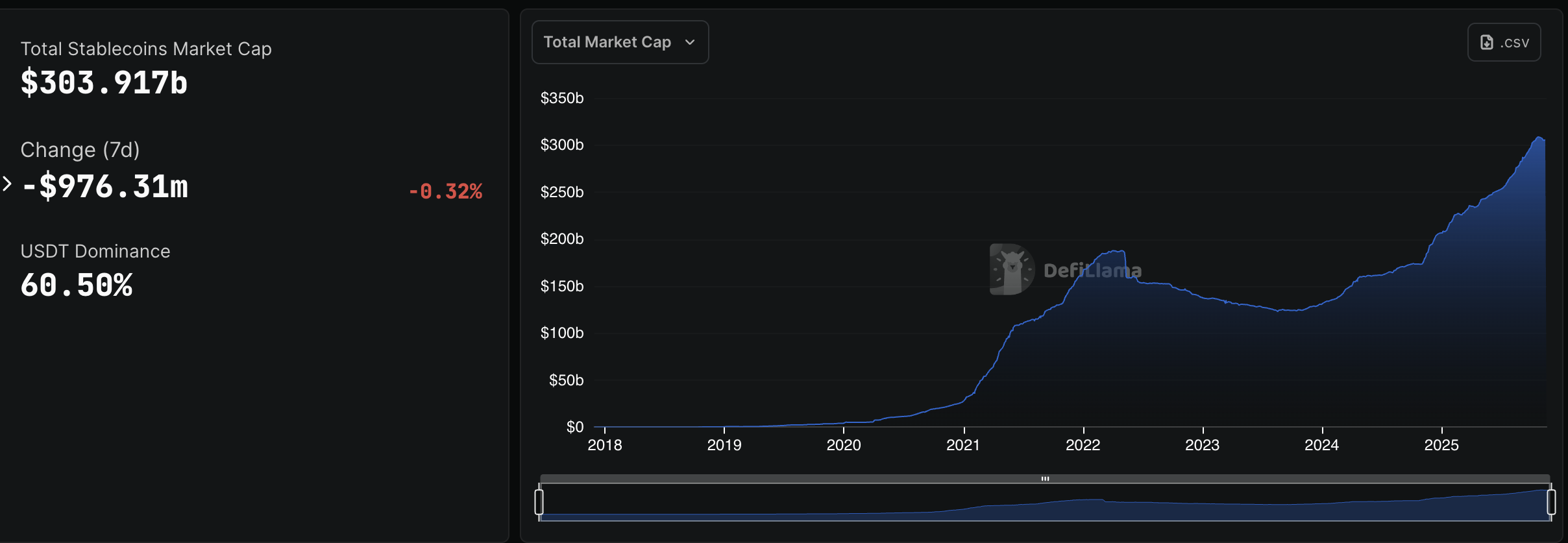European Central Bank Official Warns About the Impact of a Potential Stablecoin Sell-Off
A European Central Bank official warns that a large wave of stablecoin redemptions could pressure the ECB to adjust interest rates. With stablecoins surpassing a $300 billion market cap, officials fear rising financial-stability and monetary-sovereignty risks as adoption accelerates.
A mass redemption of stablecoins could force the European Central Bank (ECB) to adjust its monetary policy, a senior official warns.
Concerns are mounting about the risks posed by stablecoins, which have experienced strong growth, with their market cap exceeding $300 billion in 2025.
European Central Bank Raises Concerns Over Stablecoins
Olaf Sleijpen, President of De Nederlandsche Bank and a member of the European Central Bank’s Governing Council, has warned that the rapid expansion of stablecoins could have serious implications for Europe’s economy. Speaking about the accelerating growth of dollar-based stablecoins, he noted that if their adoption continues at the current pace, they could eventually reach a level where they become systemically important.
Furthermore, he emphasized that a wave of large-scale redemptions, essentially a run on stablecoins, could trigger market turbulence that extends far beyond the crypto sector.
“If stablecoins are not that stable, you could end up in a situation where the underlying assets need to be sold quickly,” Sleijpen told the Financial Times.
In such a scenario, he said that the ECB might be forced to reconsider its monetary policy stance. According to Sleijpen, the central bank could be pushed to adjust interest rates.
Nonetheless, it is unclear whether that would mean tightening or loosening policy. He emphasized that authorities would first rely on financial stability tools before turning to interest rate changes.
Hypothetically, if investors rush to redeem stablecoins, issuers might need to liquidate Treasury holdings quickly. Sharp sell-offs could drive up US government debt yields, leading to spillover effects in Europe’s bond markets.
When bond yields rise, financial conditions tighten, which can slow economic activity and affect inflation. The ECB might then have to adjust rates not for domestic reasons, but to counter instability from the crypto sector.
Previously, Jürgen Schaaf, an adviser in the ECB’s Market Infrastructure and Payments Division, issued a similar warning. He cautioned that if stablecoins become widely used in the euro area for payments, savings, or settlement, they could gradually weaken the ECB’s ability to steer monetary conditions.
Schaaf noted that this shift could mirror the dynamics seen in dollarised economies, where users gravitate toward the dollar for perceived safety or better returns.
According to Schaaf, a dominant role for dollar stablecoins would ultimately reinforce America’s financial and geopolitical position, enabling cheaper debt financing and expanding its global influence. Meanwhile, Europe would face relatively higher borrowing costs, reduced monetary policy flexibility, and greater strategic dependence.
“The associated risks are obvious – and we must not play them down. Non-domestic stablecoin’s challenges range from operational resilience, the safety and soundness of payment systems, consumer protection, financial stability, monetary sovereignty, data protection, to compliance with anti-money laundering and counter-terrorism financing regulations,” he added.
Stablecoin Adoption Accelerates Amid Market Expansion
The warnings from European officials come at a time when the stablecoin industry is experiencing rapid expansion amid major regulatory shifts. According to data from DefiLlama, the sector’s market capitalization has grown by nearly 48% this year alone. It now sits at over $300 billion.
 Stablecoin Market Performance. Source:
DefiLlama
Stablecoin Market Performance. Source:
DefiLlama
Tether continues to dominate the market with a market capitalization of approximately $183.8 billion. Its investment footprint has also grown significantly. The firm is the 17th-largest holder of US government debt worldwide — ahead of countries such as South Korea.
Additionally, stablecoin usage has accelerated. Monthly settlement volumes increased from $6 billion in February to $10.2 billion in August, a rise of approximately 70%.
Business-to-business activity has been particularly strong. It doubled to $6.4 billion per month and now represents almost two-thirds of all payment flows in the sector.
Forecasts suggest the expansion is far from over. Citigroup estimates that the global stablecoin market could swell to around $3.7 trillion by 2030. The US Treasury Department projects the market could reach $2 trillion as early as 2028.
If these projections materialize, stablecoins would become deeply integrated into global finance, amplifying both their economic relevance and the regulatory challenges surrounding them.
Read the article at BeInCryptoDisclaimer: The content of this article solely reflects the author's opinion and does not represent the platform in any capacity. This article is not intended to serve as a reference for making investment decisions.
You may also like
Bitcoin News Today: "As ETFs Experience Rapid Growth, Metaplanet Remains Steadfast in the Battle for Bitcoin Leadership"
- Metaplanet holds 30,823 BTC, aiming for 210,000 by 2027 via preferred shares. - MicroStrategy's market value discounts raise debt concerns despite CEO's confidence. - ETF growth and institutional interest shift Bitcoin's perception as a long-term asset. - Japan's $2T assets drive Metaplanet's Bitcoin-backed fixed-income strategy.

Bitcoin News Today: Bitcoin’s Plunge Below $96K Sparks Concerns Over a Bear Market Resurgence Similar to 2024
- Bitcoin fell below $96,000, erasing 2025 gains and triggering $44M in liquidations as ETF outflows hit $870M. - Market cap dropped 5.4% to $3.36T, with Ethereum and XRP hitting multi-month lows amid weak demand. - Chain metrics show 815,000 BTC sold by long-term holders, while Bull Score Index collapsed to 20 from 80. - Technical indicators warn of further declines below $93,500, testing 2024 bear market lows if support breaks. - MicroStrategy added $835M BTC despite criticism, but fear/greed index hit 1
Bitcoin News Today: Bitcoin ETFs See $870M Outflow as Long-Term Holder Selling Drives Price Near $80k
- Bitcoin’s price nears $80,000 as fear indices hit 16, signaling panic-driven capitulation. - $870M ETF outflows and 815,000 BTC sold by LTHs accelerate downward pressure since October. - Key technical levels breached: 365-day SMA broken, 50-week SMA at risk, bear market risks rising. - Ethereum faces 200-day EMA resistance; whales accumulate ETH despite $3.66B in ETF outflows. - STHs near 12.79% losses, 6-12M holder cost basis at $94,000 may offer temporary support.

Bitcoin News Update: Bitcoin ETF Sees $1.5 Billion Withdrawals While Institutional Investors Increase Their Holdings
- BlackRock's IBIT ETF saw $1.5B net outflows over 10 days as investors reassess Bitcoin exposure amid volatility. - Harvard University boosted IBIT holdings to $442.8M, surpassing its combined stake in major tech firms, while diversifying into gold . - Institutional ownership in IBIT rose to 29% QoQ, with UAE entities and sovereign wealth funds among key holders, signaling crypto's growing institutional acceptance. - KuCoin expanded institutional services as ETF outflows highlight market recalibration, wi
